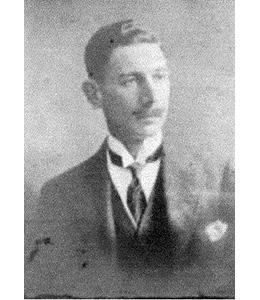Died of pneumonia and heart failure aged 51
Buried at Loton Park
Bryan Baldwin Mawddwy was born at Park Street, London, the elder son of Sir Baldwyn Leighton 8th Bt, MP, and his wife, the Hon Eleanor Warren, sister and heiress of the 3rd and last Baron de Tabley.
Educated at Radley, he came up to Christ Church in 1888. He was a very daring horseman both on the hunting field and in point-to-point racing. In 1901-04 he had his own pack of foxhounds.
On 3 December 1890, Sir Bryan married Margaret Frances Fletcher. Their elder son was born on 9 February 1892, and the younger, a year later, on 13 February 1893.
In 1891 he was commissioned a Second Lieutenant in the Shropshire Yeomanry and promoted to Lieutenant in 1895. He was in Bechuanaland in 1896-97 (medal and clasp), and was promoted to Captain the following year. He succeeded his father to the baronetcy in 1897.
Sir Bryan joined the Americans in Spanish-American war
The New York Times of 23 April 1898 headlined:
“A BARONET HERE TO FIGHT
Capt. Sir Bryan Leighton of England Wants to Help Avenge the Maine”
The article announced that he was amongst the passengers who had arrived on the steamship Germanic, the previous day. He had a large amount of luggage bearing his name which was bonded through to Canada in case the American government refused his services. He said that he’d come to offer his services to the United States Government to fight the Spaniards. He withheld the name of his regiment but said that he had leave of absence.
“The aristocratic volunteer is in appearance a smooth faced youth of slight build. He wore a grey cheviot suit and a black Fedora hat.”
In his book,” The Rough Riders” published in 1899, Theodore Roosevelt said
“Another English visitor was Sir Bryan Leighton, a thrice-welcome guest, for he most thoughtfully brought to me half a dozen little jars of devilled ham and potted fruit, which enabled me to summon various officers down to my tent and hold a feast.”
Sir Bryan was in South Africa in 1899 and 1900 during which time, the New York Times reported, his wife, “unusually for a woman”, was Master of his Fox Hounds.
In 1904, during the Russo-Japanese War, he was working as a war correspondent.
"Captain Bryan Baldwin Mawddwy Leighton recently arrived at Shanghai en route to the front as correspondent to the Manchester Guardian and special artist of the Illustrated London News. This will be the fourth campaign that Sir Bryan has been through. He served in the Boer War and was in command of the first patrol of Dundonald's cavalry to enter Ladysmith with General Buller's relief force. During the rest of the war he was with the 6th Dragoons under General French When the present war broke out he was hunting moose in Alaska, but at the request of the papers mentioned he at once proceeded to Japan and after going through the necessary formalities boarded the steamer Siberia and arrived at Shanghai from whence he went to Chefoo.
“Interviewed by a representative of the Shanghai Times he said that the delay in the land fighting was due to the selling of the Japanese plan of campaign to the Russians by a Colonel of Engineers in the War Office, who with several others implicated has been executed. The price paid for the information was $100,000 and in consequence the whole plan had to be reconstructed, the Japanese troops meanwhile having to mark time."
from the Straits Times, 28 May 1904
He was awarded the Territorial Decoration on 20 June 1911. By 1913, he was with the Turkish Forces in the Balkan war, and made a film which is in the Imperial War Museum.
He was mobilised at the outbreak of war and commanded the Westmoreland and Cumberland Yeomanry with the rank of Lieutenant-Colonel. He passed his Aero Club Certificate on 3 October 1913 at the Graham-White School in Hendon flying a Graham-White biplane, the certificate number is 641, and his address at the time was 8 Wellington Court, Knightsbridge SW. On 15 February 1915, he passed through the Upavon Flying School and was gazetted as Flying Officer RFC.
He saw service in France with the RFC. Taking a keen interest in the work of airmen, he himself made a number of daring parachute descents from aircraft in flight in order to test new devices.
His elder son who was twice Mentioned in Dispatches and awarded the Military Cross, died of injuries following a flying accident on 7 May 1917.
Sir Bryan died on 19 January 1919 at 8, Wellington Court, Knightsbridge, a victim of the Spanish ‘flu epidemic, after three day‘s illness. He was buried, by his own wish, in the Park at Loton and a plaque in his memory is in the church of St. Michael and All Angels, Alberbury in Shropshire.
Probate was granted to his wife. He left £32,522-14s-9d.


